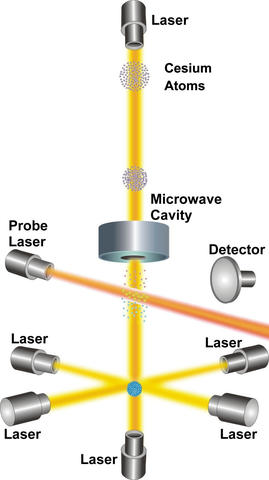
There's nothing like the joy of receiving a precision timepiece as a holiday gift. Thanks to the Commerce Department's National Institute of Standards and Technology, the whole world can share that feeling because the agency today placed into operation a new atomic clock that will neither gain nor lose a second in nearly 20 million years.
Termed NIST-F1, the new cesium atomic clock at NIST's Boulder, Colo., laboratories, began its role as the nation's primary frequency standard by contributing to an international pool of the world's atomic clocks that is used to define Coordinated Universal Time (known as UTC), the official world time. Because NIST-F1 shares the distinction of being the most accurate clock in the world (with a similar device in Paris), it is making UTC more accurate than ever before. NIST-F1 recently passed the evaluation tests that demonstrated it is approximately three times more accurate than the atomic clock it replaces, NIST-7, also located at the Boulder facility. NIST-7 has been the primary atomic time standard for the United States since 1993 and is among the best time standards in the world.
NIST-F1 is referred to as a fountain clock because it uses a fountain-like movement of atoms to obtain its improved reckoning of time. First, a gas of cesium atoms is introduced into the clock's vacuum chamber. Six infrared laser beams then are directed at right angles to each other at the center of the chamber. The lasers gently push the cesium atoms together into a ball. In the process of creating this ball, the lasers slow down the movement of the atoms and cool them to near absolute zero.
Two vertical lasers are used to gently toss the ball upward (the "fountain" action), and then all of the lasers are turned off. This little push is just enough to loft the ball about a meter high through a microwave-filled cavity. Under the influence of gravity, the ball then falls back down through the cavity.
As the atoms interact with the microwave signal—depending on the frequency of that signal—their atomic states might or might not be altered. The entire round trip for the ball of atoms takes about a second. At the finish point, another laser is directed at the cesium atoms. Only those whose atomic states are altered by the microwave cavity are induced to emit light (known as fluorescence). The photons (tiny packets of light) emitted in fluorescence are measured by a detector.
This procedure is repeated many times while the microwave energy in the cavity is tuned to different frequencies. Eventually, a microwave frequency is achieved that alters the states of most of the cesium atoms and maximizes their fluorescence. This frequency is the natural resonance frequency for the cesium atom—the characteristic that defines the second and, in turn, makes ultraprecise timekeeping possible.
The NIST-F1 clock's method of resolving time differs greatly from that of its predecessor, NIST-7. That device—and the versions before it—fired heated cesium atoms horizontally through a microwave cavity at high speed. NIST-F1's cooler and slower atoms allow more time for the microwaves to "interrogate" the atoms and determine their characteristic frequency, thus providing a more sharply defined signal.
NIST-F1 was developed by Steve Jefferts and Dawn Meekhof of the Time and Frequency Division of NIST's Physics Laboratory in Boulder, Colo. It was constructed and tested in less than four years.
This new standard is more accurate by a wide margin than any other clock in the United States and assures the nation's industry, science and business sectors continued access to the extremely accurate timekeeping necessary for modern technology-based operations. Together with the U.S. Naval Observatory in Washington, D.C., NIST provides official time to the nation.
How the NIST-F1 Cesium Fountain Clock Works
Step 1
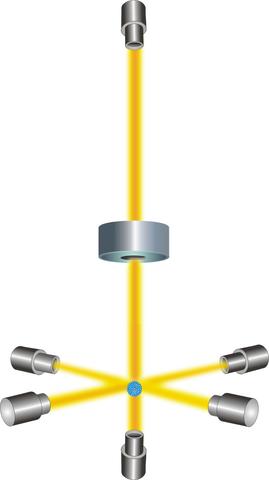
Step 2
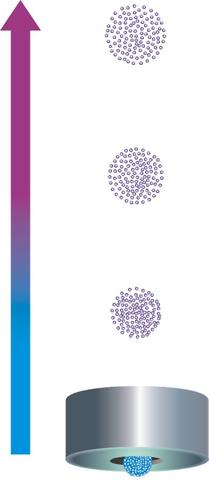
Step 3
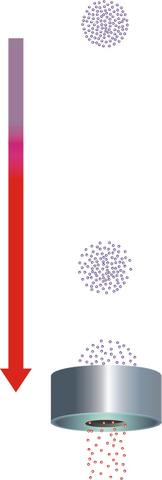
Step 4
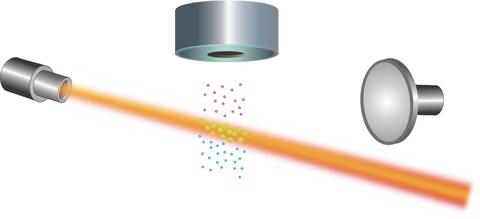
A Brief History of Atomic Clocks
1945 — Isidor Rabi, a physics professor at Columbia University, suggests a clock could be made from a technique he developed in the 1930's called atomic beam magnetic resonance.
1949 — Using Rabi's technique, NIST (then the National Bureau of Standards) announces the world's first atomic clock using the ammonia molecule as the source of vibrations.
1952 — NIST announces the first atomic clock using cesium atoms as the vibration source. This clock is named NBS-1.
1954 — NBS-1 is moved to NIST's new laboratories in Boulder, Colo.
1955 — The National Physical Laboratory in England builds the first cesium-beam clock used as a calibration source.
1958 — Commercial cesium clocks become available, costing $20,000 each.
1960 — NBS-2 is inaugurated in Boulder; it can run for long periods unattended and is used to calibrate secondary standards.
1963 — The search for a clock with improved accuracy and stability results in NBS-3.
1967 — The 13th General Conference on Weights and Measures defines the second on the basis of vibrations of the cesium atom; the world's timekeeping system no longer has an astronomical basis.
1968 — NBS-4, the world's most stable cesium clock, is completed. This clock was used into the 1990s as part of the NIST time system.
1972 — NBS-5, an advanced cesium beam device, is completed and serves as the primary standard.
1975 — NBS-6 begins operation; an outgrowth of NBS-5, it is one of the world's most accurate atomic clocks, neither gaining nor losing one second in 300,000 years.
1989 — The Nobel Prize in Physics is awarded to three researchers—Norman Ramsey of Harvard University, Hans Dehmelt of the University of Washington and Wolfgang Paul of the University of Bonn—for their work in the development of atomic clocks. NIST's work is cited as advancing their earlier research.
1993 — NIST-7 comes on line; eventually, it achieves an uncertainty of 5 parts in 10 to the 15th power, or 20 times more accurate than NBS-6.
1999 — NIST-F1 begins operation with an uncertainty of 1.7 parts in 10 to the 15th power, or accuracy to about one second in 20 million years, making it the most accurate clock ever made (a distinction shared with a similar standard in Paris).
High-Accuracy Timekeeping
Who Needs High-Accuracy Timekeeping and Why?
High-accuracy timekeeping is critical to a number of important systems, including telecommunications systems that require synchronization to better than 100 billionths of a second and satellite navigation systems such as the Defense Department's Global Positioning System where billionths of a second are significant. Electrical power companies use synchronized systems to accurately determine the location of faults (for example, lightning damage) when they occur and to control the stability of their distribution systems. In the domain of space exploration, radio observations of distant objects in the universe, made by widely separated receivers in a process called long-baseline interferometry, require exceedingly good atomic reference clocks. And navigation of probes within our solar system depends critically on well-synchronized control stations on earth.
Time is also important in the ordering of many human activities including the activities of financial markets. Time/date stamps are used to identify transactions so that these can be placed in order, a process that is becoming increasingly important as commerce moves electronically at faster and faster speeds. The need for good timing in this area is emphasized by a recent Securities and Exchange Commission-approved rule of the National Association of Securities Dealers that requires all member brokers synchronize their time stamps to NIST.
The time-related quantity called frequency, basically the rate at which a clock runs, is needed by the radio and television broadcast industry to maintain proper control of transmissions and thus avoid interference between stations. Frequency is also the basis for many electronic systems such as event counters, and many physical quantities such as length, voltage, pressure, and so on are often transformed to frequency, since frequency is a quantity that can be measured with very high precision.
How Does NIST Support These High-Technology Requirements?
The most fundamental way in which NIST supports such commercial activities is through its traditional role in providing the very accurate measurements needed to assure that specifications of high-technology equipment can be trusted. In fact, most countries would not accept United States high-technology exports without a guarantee that the specifications for this equipment are based on measurements that are traceable to NIST, which must then be sure that these measurements are compatible with those of the rest of the world. So, one key use of this new standard is to serve as a reference for supporting specifications for equipment manufactured in this country.
Beyond this fundamental mission role, NIST works to distribute timing signals to a wide range of users through the Internet, by telephone, through radio broadcast signals, and by means of very precise signals distributed by satellite. The usage of NIST's Internet Time Service, now receiving more than 500 million calls per year, is growing extremely rapidly. Radio time broadcasts from stations WWV and WWVB are used to set a large number of clocks; in fact, there is a growing list of consumer products (desk clocks, wristwatches, etc.) that use these radio broadcasts to maintain accurate time and even handle daylight saving time changes automatically. At the highest level of accuracy, NIST supports scientific studies, the space program and the development of advanced timing equipment by delivering timing signals using satellite transfer methods.
How does NIST disseminate its time and frequency information?
The oldest service is radio station WWV, near Fort Collins, Colo. It can be received all over the world and broadcasts at 2.5, 5, 10, 15 and 20 megahertz on the short wave band. A sister station, WWVH, broadcasts to the Pacific basin from Kauai, Hawaii, on everything but the 20 megahertz frequency. The broadcasts include standard frequencies and time intervals, the time (both voice and digital code), astronomical time corrections, and public service announcements such as marine weather, geophysical alerts and radio propagation information. The accuracy of these broadcasts, as received, is between one and 100 milliseconds, depending on the distance to the receiver. A telephone time service, which carries the WWV broadcast, is available by dialing (303) 499-7111 (a toll call outside the Denver Metro area). WWV has been broadcasting since 1923.
Another NIST radio station, WWVB, broadcasts a digital time code at the standard frequency of 60 kilohertz. Also located near Fort Collins, this low frequency station, which covers the continental U.S., has an accuracy for time comparison of between 0.1 and one millisecond. Its 60 kilohertz carrier frequency can be used for frequency calibrations with an accuracy of better than 1 part in 100 billion.
The Automated Computer Time Service (ACTS) provides millisecond accuracy for computer clocks and other digital systems using dial-up telephone lines. This service includes automatic compensation for telephone-line delay and advance notices of changes to and from daylight savings time as well as leap seconds. NIST's time signals also are available on the Internet. A visual display of the correct time can be seen at www.time.gov, a service provided jointly with the U.S. Naval Observatory.
NIST time can also be obtained via the Internet to set the internal clocks of computers automatically.
NIST also disseminates time code information via satellite, utilizing two of the National Oceanic and Atmospheric Administration's GOES weather satellites. The coverage includes North and South America plus portions of the Atlantic and Pacific oceans. This digital time code is accurate to within 100 microseconds, depending on knowledge of the position of the satellite.

